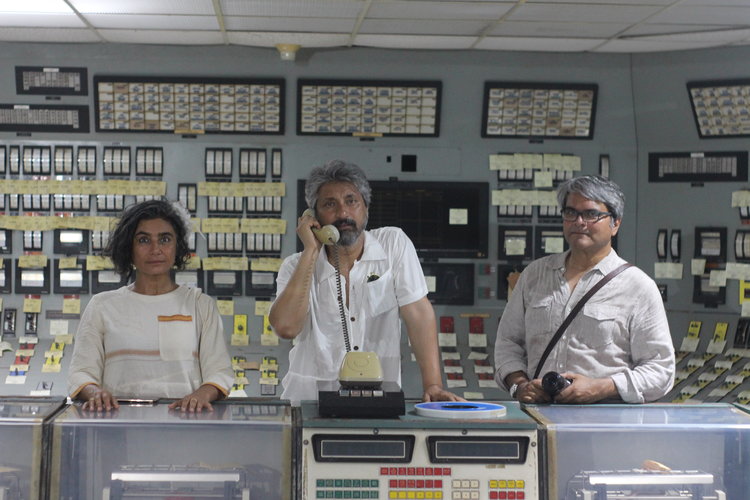
Raqs Media Collective
Event
August 3, 2020
Raqs Media Collective, formed in 1992 and based out of New Delhi, is comprised of three practitioners, Jabeesh Bagchi, Monica Narulu and Suddhabrata Sengupta.

The name ‘raqs’ stems from a word in Urdu, Persian and Arabic that means ‘the state that whirling dervishes enter when they whirl’, which is indicative of the collective’s dynamic, contemplative and mesmerising work. Their practice is not limited to the creation of art and exhibitions, but has collaborated with a range of architects, programmers, writers, curators and theatre directors to produce a plethora of talks, websites, conferences, books, journals, situations and documentary films. Grounded in art theoretical research, historical inquiry and philosophical speculation, Raqs engages with different ‘documents’ and concepts of ‘the archive’ to explore the volatility of history and memory, often in relation to post-colonialism and the legacy of emancipation.

Exhibitions curated by Raqs include ‘Why Not Ask Again’ (Shanghai Biennale 2016-2017) and they were recently appointed artistic director of the Yokohama Triennale in 2020. Their work has been exhibited at Documenta, the Venice, Sao Paolo, Manifesta, Istanbul, Shanghai, Sydney and Taipei Biennales, while other solo shows at museums include MUAC (Mexico City 2015), Tate Exchange (London 2016) and the Whitworth Art Gallery (Manchester 2017).
Artist Residency

In the lead up to their ESKWELA seminar, Raqs Media Collective completed a week-long residency with Bellas Artes Projects. Raqs described their approach to creative collaboration as a piecemeal process of progression; often beginning with visual, historical or contextual stimuli, the group allows for ideas to develop through a combination of personal research and group discussion.
Learning about Bataan as an important religious and historical site contributed to this context responsive approach. A guided tour of the Bataan World War II museum by a Death March (1942) veteran was hugely insightful. While visits to several religious sites, including the Parish of Saint Catherine of Siena, the Saint Dominic Church of Abucay and Mt. Samat, tied in with the group’s interest in the role of local mythologies, icons and gods in shaping popular memory and imagination.
The blend of historical and innovative imagery with production techniques found in the artisan workshops at Las Casas were a fertile source of discursive inspiration, especially the labour-intensive process of ceramic tile production.
Raqs was also interested in the Bataan Nuclear Power Plant’s vulnerable geographical location — as a metaphor for the volatility and fragility of history and memory — and in relation to their upcoming tour of the Large Hadron Collider in Switzerland later this year.

Raqs Media Collective led an ESKWELA seminar on the topic of Context Responsive Art Practice. In response to the contextual environment of the Philippines as an active sites of volcanic activity, Raqs discussed the subterraneous nature of memory and magma and their equally unpredictable eruptions. This metaphor led to an investigation of memory, explored via the participants own examples of fault lines (sites of collision) and lieux de memoir (objects or places that seemingly absorb the past in order to deliver them later as memories).
The session was conducted according to their practical thinking session, where thinking is considered a form of making. The conversation from day one was centered on the topics on accidents of meeting tectonic plates, fragments, and narratives of facticity which continues onto day two, but with more on the participant’s exploration of these in their own work and practice.
Artist Talk

On June 7 (Friday) to conclude their residency, Raqs Media Collective conducted an artist talk at the Outpost in Makati entitled “Diving and Thinking.”
The Collective began their artist talk with an introduction to their preoccupation with the concept of “diving” and the thought process that goes along with it, “diving as thinking and thinking as diving.” As the collective was formed because of a proclivity for conversation, their artist talk was also in the form of a conversation that brings into light the thought processes and methods involved in the creation of their work.
In their recent Pamphilos (2019) exhibition at the Onassis Foundation in Athens, they were concerned with the figure of the deep sea diver that became the main feature of their work. The statue of a broken philosopher, the word ‘pamphilos’ inscribed in a cup, and the goddess Metis all contributed to the series of questions and conversations that occupied their thinking and produced their recent work that found expression in bringing things from the deep sea and trying to make a whole with found parts.
One of their practices is thinking with images where they probe into the idea of moving images as a mechanism to make you think more that also creates its own world exploring humanity, technology, and posthumanity. The triangulation of their thoughts, sensibilities, and ideas that they jostle through in their conversations find material expression in their works which deals heavily with questions of space and time, how things emerge and are connected.
They showed the audience a clip from their work The Blood of Stars: A Walk in Ten Scenes (2017) wherein they meditate on iron, the metal that is present from our blood to the stars that we see at night. In this film, their research effort was from biology, ecology, mining, to the military which produced a story from under the ground, literally, as scenes were filmed from the inside tunnels of mountains.
The collective espouses the discursive power, rather than the material power, of art and the artist’s ability to transform a landscape because of his discursive presence. To them, this is what artists should have or at least claim greater forces of.
Mobility supported by the Asia-Europe Foundation (ASEF).
Bellas Artes Projects
2/F Victoria Towers
Panay Avenue cor. Timog Avenue
Quezon City 1103
info@bellasartesprojects.org
programmes and interesting events.
